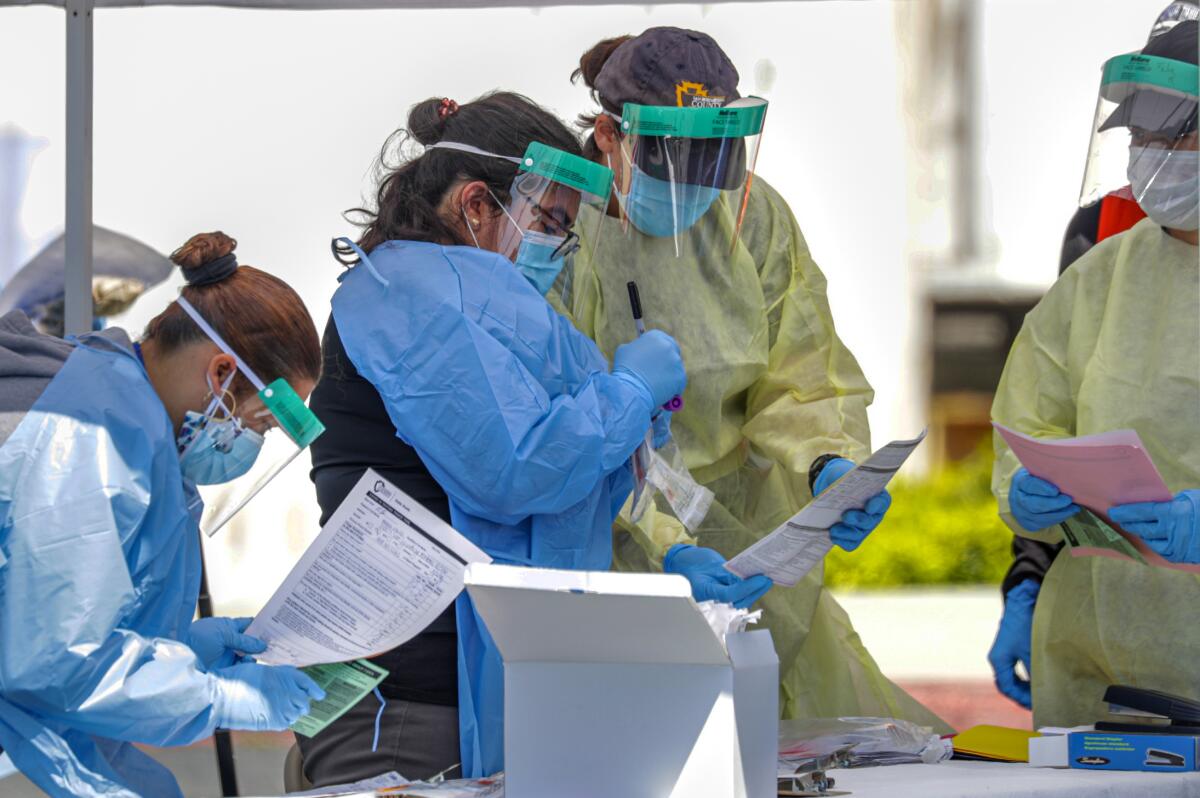Op-Ed: Coronavirus revealed gaps in the U.S. ability to track infectious disease. That’s fixable

In the U.S., federal expenditures for public health have fallen from 1% of total healthcare expenditures in the early 1970s to 0.3% in 2018. But there is nothing like a global pandemic to motivate the public to pause and consider the proper role of government in healthcare and how to improve the system. As we move forward, one key component of a strengthened public health system should be a real-time universal data system for tracking infectious disease.
Collecting and analyzing real-time data on the number of cases and deaths during a disease outbreak is crucial in tracking the spread of disease and gauging its impact. But the COVID-19 pandemic has shown that these numbers can’t provide reliable information without the relevant denominator: the number of people tested.
That’s been a challenging number to obtain. Early on all the coronavirus testing was performed by the Centers for Disease Control and Prevention (CDC) so it was easy to track both the number of positive tests and the number of patients tested. In late February, state public health labs joined the effort, followed soon after by university and commercial labs.
That’s a lot of data sources, and it has been challenging to get accurate numbers about how many people have been tested. The CDC tracks the number of tests performed by 90 public health laboratories. The COVID tracking project is more expansive, attempting to include all other testing sites. Currently their estimate of the number tested is 10 times that of CDC. They work hard to get the data, culling from press releases, news conferences and media reporting as well as public health authorities in states, districts and territories. But no one has complete data, and labs have different protocols for what they release. It shouldn’t be this hard.
Having an accurate picture of the number tested is crucial for responding to any disease outbreak. It is important for determining the frequency of disease in a population and the trajectory of the epidemic, as we’re seeing with COVID-19. At the beginning of April, New York state had more than twice the number of cases per capita than neighboring New Jersey, which suggested on its face that the outbreak was much worse in New York. But that was only because New York’s rate of testing per capita was also more than twice that of New Jersey. Over the last 10 days, the difference in testing per capita has narrowed — and thus so has the difference in cases per capita. In other words, the apparent severity of the outbreak is sensitive to the scale of testing.
Equally important is how the number tested affects our perceptions of what it means to get COVID-19. The conventional measure of this is case-fatality, or the percentage of those with the disease who die.
Case-fatality is exquisitely sensitive to the breadth of testing. Consider the U.K. and Iceland: Currently, case-fatality in the U.K. is more than 10 times that in Iceland (13% vs. 0.5%). While it might be tempting to conclude that Iceland delivers better COVID care, that would be a mistake. The U.K. has tested about 0.5% of its population (and generally only symptomatic patients) while Iceland has tested more than 10% of its population (including asymptomatic individuals).
Clinical laboratories are the right place to start to build a real-time universal data system to include denominator data. Lab data have been computerized for decades; it was arguably the first digitized component of the electronic medical record. Now we need to bring the nation’s labs together (as has been done in the state of New York) and hammer out a uniform infectious disease findings data set that they all can contribute to in real time.
The data set would catalog the number positive and the number tested for all infectious diseases — along with simple data about who they are: age, inpatient versus outpatient, and whether they have symptoms or not. Coronavirus antibody testing, too, ought to be part of the data. Antibody testing helps us learn how many have already had the disease and who can get back to work.
These kind of data will be of use in monitoring not just the coronavirus, but also influenza and food-borne outbreaks, and it will be of great use should we experience a second COVID wave.
Hospital data are equally important in infectious disease outbreaks. There has been a uniform hospital discharge data set since the mid 1970s, but information can have a lag time of one to two years. Simple, skeletal data on the number of patients seen in the ER, the number admitted, the number admitted to the ICU and the number requiring ventilators would have obvious value in gauging the effects of infectious disease outbreaks on medical care resources. The CDC is currently proposing a voluntary system to provide these data.
Healthcare systems and insurance companies in the United States have been very good at quickly tracking services and generating bills. There is no reason the United States shouldn’t be equally good at quickly constructing a picture of what is going on in our healthcare system.
That is the proper role of government. Congress is undoubtedly considering more COVID-related legislation. It should give the CDC authority to require labs to send relevant data for infectious disease and hospitals to send skeletal data on real-time utilization. Pass it now; implement it before the next wave.
H. Gilbert Welch is a senior researcher in the Center for Surgery and Public Health at Brigham and Women’s Hospital in Boston.
More to Read
A cure for the common opinion
Get thought-provoking perspectives with our weekly newsletter.
You may occasionally receive promotional content from the Los Angeles Times.










